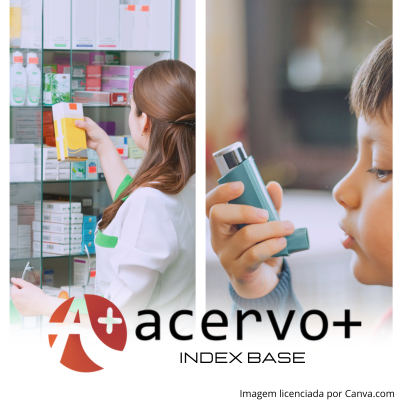Teleatendimento farmacêutico no cuidado aos pacientes com asma
##plugins.themes.bootstrap3.article.main##
Resumo
Objetivo: Investigar a eficácia do teleatendimento farmacêutico para pacientes com asma, utilizando diversos métodos, incluindo vídeo chamada e telefonema. Métodos: Revisão Sistemática da Literatura, utilizadas as bases de dados Literatura Latino-Americana e do Caribe em Ciências da Saúde (LILACS), o Medline via PubMed, a Scielo, o Web of Science, a Scopus, a Cochrane library e o EMBASE. Foram incluídos estudos originais, completos e sem restrição de idioma, as buscas foram realizadas até março de 2022. Resultados: Sete estudos, incluindo ensaios clínicos randomizados e estudos piloto, foram analisados, demonstrando melhorias na adesão à terapia inalatória, redução de custos de atendimento e taxas de hospitalização. A qualidade metodológica dos ensaios clínicos foi considerada alta. Considerações finais: A telemedicina, embora promissora, enfrenta desafios relacionados à infraestrutura de acesso à Internet, especialmente em áreas rurais e países de baixa renda. Portanto, embora a tecnologia tenha o potencial de transformar os serviços de saúde, é essencial considerar as desigualdades de acesso ao implementar essas abordagens.
##plugins.themes.bootstrap3.article.details##
Copyright © | Todos os direitos reservados.
A revista detém os direitos autorais exclusivos de publicação deste artigo nos termos da lei 9610/98.
Reprodução parcial
É livre o uso de partes do texto, figuras e questionário do artigo, sendo obrigatória a citação dos autores e revista.
Reprodução total
É expressamente proibida, devendo ser autorizada pela revista.
Referências
2. BROWN SFS. Impact of telepharmacy services as a way to increase access to asthma care. J Asthma. 2017; 54(9): 961-967.
3. BYNUM A, et al. The effect of telepharmacy counseling on metered-dose inhaler technique among adolescents with asthma in rural Arkansas. Telemed J E Health. 2001; 7(3): 207-217.
4. CYLUS J e PAPANICOLAS I. An analysis of perceived access to health care in Europe: how universal is universal coverage? Health Policy. 2015; 119: 1133-1144.
5. DAT TV, et al. Telepharmacy: A Systematic Review of Field Application, Benefits, Limitations, and Applicability During the COVID-19 Pandemic. Telemedicine Journal and E Health: The Official Journal of the American Telemedicine Association [Internet]. 2022.
6. ELBEDDINI A YEATS A. Pharmacist intervention amid the coronavirus disease 2019 (COVID19) pandemic: from direct patient care to telemedicine. J Pharm Policy Pract. 2020; 13: 23.
7. ERICKSON SRe WORKMAN L. Use of a paging system to improve medication self- management in patients with asthma. J Am Pharm Assoc. 1998; 38(6): 767-769.
8. GEORGE MC. Evolving role of the community pharmacist in chronic disease management - a literature review. Ann Acad Med Singapore. 2010; 39(11): 861-867.
9. GINA. Global Strategy for Asthma Management and Prevention, 2022.
10. GLOBAL BURDEN OF DISEASES AND INJURIES. In 204 countries and territories, 1990 2019: a systematic analysis for the Global Burden of Disease Study 2019. Lancet. 2020; 396(10258): 1204-1222.
11. JBI. Critical Appraisal Tools. 2022.
12. KOSSE RC, et al. Effect of a mHealth intervention on adherence in adolescents with asthma: A randomized controlled trial. Respir Med. 2019; 149: 45-51.
13. MUFLHIH AM. Pharmacists’ experience, competence and perception of telepharmacy technology in response to COVID19. Int J Clin Pract. 2021; 75(7): 14209.
14. MUFLIH SM, et al. Pharmacists’ Experience, Competence, and Perception of Telepharmacy Technology in Response to COVID‐19. International Journal of Clinical Practice, 2021.
15. NELSON P. Telephonic monitoring and optimization of inhalertechnique. Telem J E Hea. 2011; 17(9): 734-740.
16. NIZNIK HK.Impact of clinical pharmacist services delivered via telemedicine in the outpatient or ambulatory care setting: A systematic review. Res Social Adm Phar. 2018; 14(8): 707-717.
17. PIZZICHINI MMM, et al. Recomendações para o manejo da asma da Sociedade Brasileira de Pneumologia e Tisiologia, Jornal Brasileiro de Pneumologia [Internet]. 2020; 46(1).
18. RAMDZAN SN, et al. School-based self-management interventions for asthma among primary school children: a systematic review. npj Primary Care Respiratory Medicine. 2021; 31(1).
19. SANKARANARAYANAN MM. A Retrospective Evaluation of Remote Pharmacist Interventions in a Telepharmacy Service Model Using a Conceptual Framework. Telemedicine and e-Health. 2014; 20(10): 893–901.
20. SANOGO FY. Universal Health Coverage and Facilitation of Equitable Access to Care in Africa. Frontiers in Public Health. 2019; 26: 7.
21. SANTOS PN. The PICO strategy for the research question construction and evidence search. Rev Lat Am Enfermagem. 2007; 15: 508–11.
22. SHDAIFAT KA. Clinical and economic impact of telemedicine in the management of pediatric asthma in Jordan: a pharmacist-led intervention. J Asthma. 2022; 59(7): 1452-1462.
23. SKREI A e RUNDQUIST M. Advances in Pharmacy: Journal of Student Solutions to Pharmacy Challenges. Pharmacy: Journal of Student Solutions to Pharmacy Challenges [Internet]. 2017 [cited 2023; 24: 1.
24. THE GLOBAL ASTHMA REPORT 2018. Auckland, New Zealand: Global. Asthma Network, 2018.
25. UNIÃO INTERNACIONAL DE TELECOMUNICAÇÕES – ITU. Medindo o desenvolvimento digital Fatos e números. 2022.
26. WHO, 2022. Asthma. Disponível em: https ://www.who.int/news-room/fact-sheets.
27. YOUNG HE. Patient and phaRmacist telephonic encounters (PARTE) in an underserved rural patient population with asthma: results of a pilot study. Telemed J E Health. 2012; 18(6): 427-433.
28. ZHAI Y. A call for addressing barriers to telemedicine: Health disparities during the COVID-19 pandemic. Psychother Psychosom. 2021; 90(1): 64-66.

